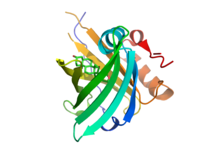Anticalin
Anticalins are proteins that are artificially produced by protein design and that are capable of binding antigens . Anticalins are structurally derived from naturally occurring lipocalins . They consist of around 180 amino acids and, with a molecular mass of less than 20 kDa, are around eight times smaller than antibodies of the IgG type. Anticalins are characterized by their superior tissue penetration compared to antibodies. They also have increased heat stability up to temperatures of over 70 ° C. By mutagenesis of amino acids of the ligand binding sites of a lipocalin, anticalins can be generated with an affinity and selectivity for an antigen. Anticalins can not only be directed against macromolecules , they are especially capable of recognizing low molecular weight structures. In contrast to antibodies, anticalins can be produced comparatively easily in large quantities in bacteria such as E. coli . Anticalins were largely developed by Arne Skerra's research group at the Technical University of Munich . The research team and the underlying technology were nominated for the German Future Prize in 2004. Anticalins are currently used as tools in science. Use as diagnostics and therapeutics is sought. The use of anticalins for the targeted transport of drugs ( drug targeting ) is also conceivable.
Individual evidence
- ↑ Skerra A: Alternative binding proteins: anticalins - harnessing the structural plasticity of the lipocalin ligand pocket to engineer novel binding activities . In: FEBS J . . 275, No. 11, June 2008, pp. 2677-2683. doi : 10.1111 / j.1742-4658.2008.06439.x . PMID 18435758 .
- ↑ ANTICALINe - Biopharmaceutical active ingredients through protein design. In: deutscher-zukunftspreis.de. Archived from the original on September 17, 2013 ; accessed on February 26, 2016 .
- ↑ Arne Skerra: Anticalins . Novel binding proteins with tailor-made ligand recognition properties through evolutionary protein design. In: BIOforum . No. 4 , 2002, p. 227–229 ( online, PDF; 908kB ( memento of March 5, 2012 in the Internet Archive ) [accessed December 6, 2010]). Anticaline ( Memento of the original from March 5, 2012 in the Internet Archive ) Info: The archive link was inserted automatically and has not yet been checked. Please check the original and archive link according to the instructions and then remove this notice.
